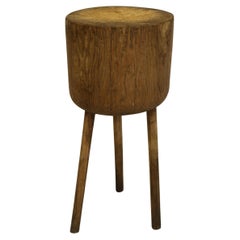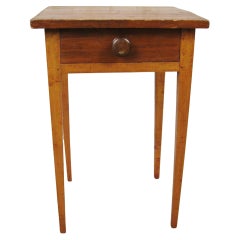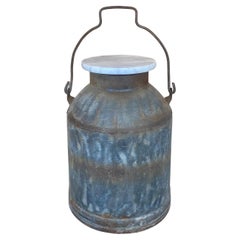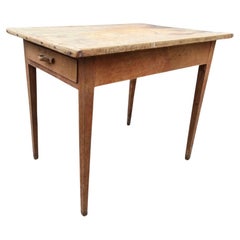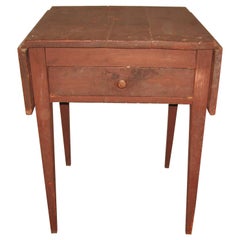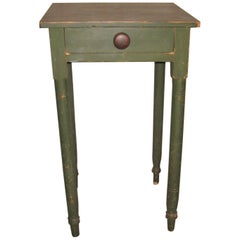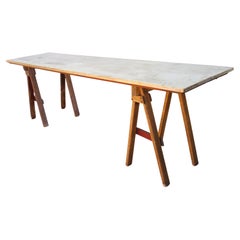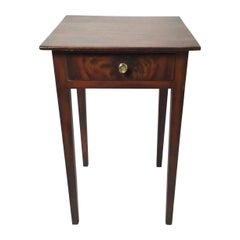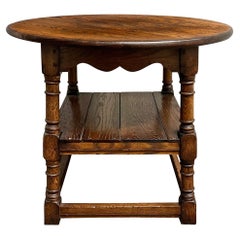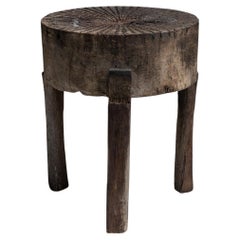Primitive End Tables
to
Height
to
Width
to
Depth
to
7
7
2,363
1,029
392
185
162
157
149
144
126
119
109
56
34
28
25
10
10
8
1
5
1
1
6
4
4
1
1
6
6
1
1
7
7
7
Style: Primitive
Antique Round Oak Butcher Block Table, Central Hungary, 19th Century
Located in New York, NY
Handsome butcher block table in solid oak.
Simple construction consists of a round, charmingly aged oak top with lots of visible character and activity on its surface as well as a ...
Category
Late 19th Century Hungarian Antique Primitive End Tables
Materials
Oak
19th Century primitive Farm work 1 Drew table with Tapered leg
Located in Newfoundland, PA
Antique Primitive Farm work 1 Draw table with Tapered Leg is a rare find for collectors and enthusiasts of historical furniture. Its great natural color, country-style theme, and woo...
Category
Early 19th Century American Antique Primitive End Tables
Materials
Pine
Rusty Primitive Milk Jug Drink Table
Located in Round Top, TX
Early 20th C. milk jug with broken and repaired marble top, the perfect weathered and rustic drink table. This fits a few wine glasses or would make an adorable little guest room nig...
Category
Early 20th Century American Primitive End Tables
Materials
Marble, Steel
American Tavern Table Circa 1800 in Original Surface
Located in Hudson, NY
Very handsome scrub top work table or Tavern table. Retaining all of the original surface and it's beautiful breadboard top. Made in both Pine and poplar, this table is very solid an...
Category
1790s American Antique Primitive End Tables
Materials
Pine, Poplar
19th Century Primitive Tapered Leg 1-Drawer Stand Old Red Paint
Located in Newfoundland, PA
19th century primitive New York 1-drawer stand, nice early stand in the old red paint. The drop leaves are very unusual for a small table like this one. Made of pine. Tapered legs ar...
Category
1850s American Antique Primitive End Tables
Materials
Pine
Early 19th Century Primitive 1 Drawer Stand in Old Green Paint
Located in Newfoundland, PA
Early 19th century primitive 1 drawer stand, nice early stand in the old green paint. Made of pine. Turned legs are pinned at the aprons. Nice Dovetaile...
Category
Early 19th Century American Antique Primitive End Tables
Materials
Pine
19th Century primitive Farm 2 Draw work table with New York leg
Located in Newfoundland, PA
Antique Primitive Farm work 2 Draw table with New York Leg is a rare find for collectors and enthusiasts of historical furniture. Its great brownish color, country-style theme, and w...
Category
Mid-19th Century American Antique Primitive End Tables
Materials
Hardwood
Related Items
Antique American Sawhorse Base Table, Circa 1900
Located in Rochester, NY
Found in East Aurora, Western New York State an 8 foot long wood sawhorse grange table. The top in bleached finish. Top lifts off sawhorses. Top w/ original iron hinges on underside ...
Category
Early 20th Century American Primitive End Tables
Materials
Iron
Early 19th Century Paint Decorated Table Stand
Located in Lambertville, NJ
A paint decorated one drawer table. A paint finish resembling mahogany over pine, American Circa 1830. 29 high, 18 wide, 17.75 deep.
Category
1830s American Antique Primitive End Tables
Materials
Pine
Handcrafted Modernist Side Drink Table
Located in London, GB
Beautifully hand-turned and handcrafted English ash ripple side table in the modernist design. This is a bespoke piece of fine quality, handmade by master-craftsmen in solid English ...
Category
21st Century and Contemporary English Primitive End Tables
Materials
Ash
Late 18th Early 19th Century Tavern Table
Located in Bridgeport, CT
A fine late 18th-early 19th century tavern/work table with strongly turned legs, ball feet, breadboard plank top and bottom H-form stretcher. The table has a long drawer on one end w...
Category
Late 18th Century Antique Primitive End Tables
Materials
Wood
Gazelle Drinks Table by Stamford Modern
Located in Westport, CT
Demure curves pair with unexpected sharpness. This solid walnut table has a lightweight aesthetic balanced on strong, hand-sculpted legs. Featuring a grey polished marble top for a n...
Category
21st Century and Contemporary American Primitive End Tables
Materials
Marble, Brass
Antique American Primitive Slab Bench
Located in Rochester, NY
Antique American primitive slab bench / butchering bench w/ four hand hewn splayed legs and a 2 1/4" thick wood slab top in the best beautifully aged rich color patina w/ naturally d...
Category
19th Century American Antique Primitive End Tables
Materials
Wood
19th Century English Oak Side Table
Located in High Point, NC
19th century oak side table from England with an octagonal shaped top with a carved decorated band and beveled edge over four turned legs, joined by a lower shelf, which mirrors the ...
Category
19th Century English Antique Primitive End Tables
Materials
Oak
Large Custom Steel Drinks Table
Located in Houston, TX
Large custom steel drinks table on tripod base. Hand-forged locally with raw steel finish. Two available (see last image) and sold individually price...
Category
2010s American Primitive End Tables
Materials
Steel
19th Century Spanish Baroque Side Table with Carved Top & Legs & Iron Stretchers
Located in Miami, FL
19th century Spanish Baroque side table with carved top and carved edgeds
Beautiful carved lyre legs and iron stretcher.
Category
Late 20th Century Spanish Primitive End Tables
Materials
Iron
$1,840 Sale Price
20% Off
H 27.56 in W 31.58 in D 19.3 in
Vintage Lane Furniture Oak Butcher Block End Table
Located in Brooklyn, NY
Straight-lined and sturdy with eye-catching wood grains, this robust table exudes the qualities that made mid-century modern design the envy of the furniture world. Walnut and oak ve...
Category
Mid-20th Century American Primitive End Tables
Materials
Wood, Hardwood, Oak, Walnut
Mid-19th Century Italian Side Table
Located in Round Top, TX
A charming mid-19th century side table from Northern Italy in painted wood. Fabulous finish and patina. A lovely shape with splayed legs, one drawer and centre shelf.
Category
Mid-19th Century Italian Antique Primitive End Tables
Materials
Wood
Antique French Round Table Entry Center Parlor Table Pedestal Renaissance 19th
Located in Tyler, TX
Superb highly carved late 19th century antique Oak round entry, hall, sofa, center, foyer, or parlor table, end table, or pedestal~~Victorian Era Renaissan...
Category
Late 19th Century French Antique Primitive End Tables
Materials
Oak
$2,875
H 33 in Dm 27.5 in
Previously Available Items
20th Century English Oak Pub Table
Located in Chicago, IL
Step into the charm of the English countryside with this delightful 20th century English oak pub table, a versatile gem that combines style and f...
Category
20th Century English Primitive End Tables
Materials
Oak
Primitive Table with Metal Inserts, France, circa 1900
Located in Culver City, CA
Primitive Table with Metal Inserts, France circa 1900.
Circular slab table with three splayed legs and iron nails imbedded into the surface.
Measures 23...
Category
Early 20th Century French Primitive End Tables
Materials
Iron
Pair of Antique Carved Figural Glass Top End Tables Side Tables
Located in Swedesboro, NJ
For customers that require professional insured delivery we are proud to have teamed up with a nationwide professional delivery company that will assist with coordinating your delive...
Category
1920s European Vintage Primitive End Tables
Materials
Glass, Walnut
Early 19th Century Primitive Spanish Oak Side Table with X Base and Stretcher
Located in Birmingham, AL
A rustic early 19th century primitive side table handcrafted of solid oak near Tarragona in the Catalan region, circa 1810s, having a rectangular plank top raised on a scalloped X ba...
Category
1810s Spanish Antique Primitive End Tables
Materials
Oak
H 30.5 in W 51 in D 31 in
Rare Natural Root Wood Table / Stool, China, 18th Century Primitive
Located in Los Angeles, CA
Natural root table, China, 18th century.
Primitive form table / stool, excellent patina.
Category
Mid-18th Century Chinese Antique Primitive End Tables
Materials
Wood
Small Burl Wood Primitive Table / Stool, China, 18th Century
Located in Los Angeles, CA
Burl wood table, China, 18th century
Primitive form small table/stool, excellent patina.
Category
Mid-18th Century Chinese Antique Primitive End Tables
Materials
Wood
Antique Round Pine Butcher Block Cutting Board Kitchen Slab Table
Located in Dayton, OH
Antique farmhouse butcher block cutting board. Made of pine featuring round tripod form with turned legs. Pedestal, side accent table, plan...
Category
Late 19th Century Antique Primitive End Tables
Materials
Pine
Black Hand-Carved Coffee Table from Africa
Located in Tulsa, OK
Bamileke Stool, African
Traditionally used one for special ceremonial seating by Bamileke Tribe of Cameroon, Bamileke "King" stools from Cameroon, this is a hand-carved original w...
Category
Late 20th Century Cameroonian Primitive End Tables
Materials
Wood
18th Century English Cricket Table
Located in Chicago, IL
A simple yet charming 18th century English oak cricket table with clean lines, including three gently tapered legs pegged to a square apron, and a round top with a beautiful well-wor...
Category
18th Century American Antique Primitive End Tables
Materials
Oak
19th Century Country French Primitive Bleached Walnut Oval Side Table
Located in Birmingham, AL
19th century Country French oval side table handcrafted in Lyon of solid walnut that has been bleached or washed to a natural finish and hand waxed to a beautiful patina, circa 1870s. Having an oval plank top over a single divided drawer, this primitive bleached side table...
Category
1870s French Antique Primitive End Tables
Materials
Walnut
Southeast Asian Patinated Bronze Rain Drum
Located in Bridgeport, CT
A Classic form rain drum with raised concentric circles on the top with a star in the center. Four textured hollow handles are around the top edge. Double strap form handles are atta...
Category
20th Century Asian Primitive End Tables
Materials
Bronze
Early Primitive English Cricket Table in Walnut, Oak and Ash
Located in Houston, TX
Early primitive English cricket table (17th century or early 18th century) in walnut, oak and ash. Irregularly round-shaped and concave walnut top supp...
Category
17th Century English Antique Primitive End Tables
Materials
Ash, Oak, Walnut
Primitive end tables for sale on 1stDibs.
Find a broad range of unique Primitive end tables for sale on 1stDibs. Many of these items were first offered in the 21st Century and Contemporary, but contemporary artisans have continued to produce works inspired by this style. If you’re looking to add vintage end tables created in this style to your space, the works available on 1stDibs include tables and other home furnishings, frequently crafted with wood, oak and other materials. If you’re shopping for used Primitive end tables made in a specific country, there are North America, United States, and Europe pieces for sale on 1stDibs. It’s true that these talented designers have at times inspired knockoffs, but our experienced specialists have partnered with only top vetted sellers to offer authentic pieces that come with a buyer protection guarantee. Prices for end tables differ depending upon multiple factors, including designer, materials, construction methods, condition and provenance. On 1stDibs, the price for these items starts at $595 and tops out at $3,200 while the average work can sell for $1,196.
Recently Viewed
View AllMore Ways To Browse
Labrador Sculpture
Lacquered Screen Pearl
Lalique Crystal Box
Lalique Ondines
Lane Acclaim Dining
Large Brass Statue
Large Carved Fish
Large Eiffel Tower
Large Famille Rose Lidded Jar
Large Porcelain Dog
Laundry Table
Laurids Lonborg On Sale
Le Fanion
Le Roi Soleil
Lifesize Marble Sculpture
Lion Head Bucket
Lion Mantel Clock
Llama Llama Vintage
